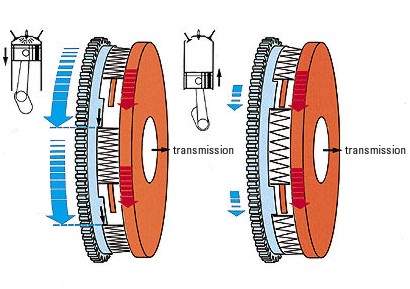Bits....undertray..airbox starter motor.....
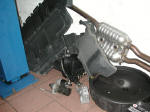
Dual Mass Flywheel
Sep 2003 - 23000 miles
I had experienced what I believed to be clutch slip some 5000 miles ago, but it seemed to get better to a point where I thought it had recovered itself.
The symptoms then returned a few weeks ago, the symptoms being stay in 5th/6th gear revs at about 3000 and floor the accelerator. As the power comes back the revs will snatch up about 300-500 revs and the car will catch up.
Investigation has led to the Dual mass flywheel being the cause.
Here's the pictorial with many bits of a TT you wouldn't normally see!
Bits....undertray..airbox starter motor.....
Dogbone engine mount with my new urethane bushes.. :o) .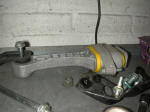
Gotta stop the engine falling out! Soft covers and care being
taken
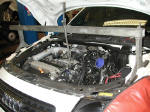
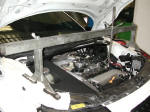
The offending Dual Mass Flywheel
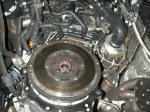
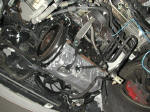
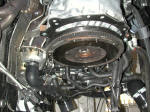
I had to leave her looking very sad whilst the part was
ordered.

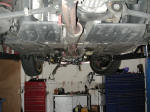
Basically its two plates with a buffer
arrangement to absorbe the early pickup torque from the engine when engaging the
clutch.
If that buffer isnt smooth and progressive for the few mm's of rotation it has
to go , but is loose then you have one plate that suddenly snatches against
another leaving you with the clutch slip symptom as when the two flywheels
snatch , the 1st flywheels snatches against the clutch plate.
In my link, my clutch was in near perfect condition. some info from luk below
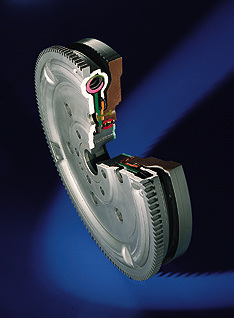
The LuK Dual-Mass Flywheel offers the following advantages:
First-class driving comfort
Absorbing of vibrations
Noise isolation
Reduction of fuel consumption
Increased comfort during shifting
Reduced wear of the synchronization
Protection from overload for the drive train
Demands on the clutch have become more difficult.
It is possible to drive modern engines at extremely low rpm. A car body
optimized in the wind-tunnel produces less wind noises. New calculation methods
help to reduce the weight of the vehicle, and lean concepts increase the
efficiency of the engines. By the help of a 5th or even a 6th gear, consumption
can also be reduced. Thin oils make precise gear shifting easier.
In a few words: There is an increase in noise sources, whereas the natural
damping diminishes. The principle of the piston engine still exists exciting
torsional vibrations in the drive train due to its periodical combustion
procedures. Gear rattle and body boom are the unpleasant consequences. Today's
drivers used to comfort are not willing to accept such background noises any
longer.
It is more important than ever before for the clutch not only to disengage and
to engage, but also to isolate efficiently the vibrations of the engine.
Physically this problem is easy to solve: There must be an increase of the
moment of transmission inertia without increasing the mass to be shifted. This
results in a reduction of the rpm producing this unpleasant resonance below the
idle speed. The resonance itself, however, gets stronger.
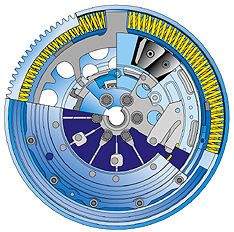
The solution is the LuK Dual-Mass Flywheel.
LuK was the first manufacturer in Europe to succeed in developing and supplying
a dual-mass flywheel for mass production realizing this physical principle and
nevertheless keeping the resonance amplitude small.
The name of the dual-mass flywheel already explains that the mass of a
conventional flywheel was divided. One part continues to belong to the moment of
engine inertia. The other part, however, increases the moment of transmission
inertia.
These two disengaged masses are connected by means of a spring/damping system. A
clutch disc without a torsion damper between the secondary flywheel and the
transmission cares for disengaging and engaging. The positive side-effect is
that due to the lower mass to be synchronized gear shifting is easier and wear
of the synchronization can be reduced.
